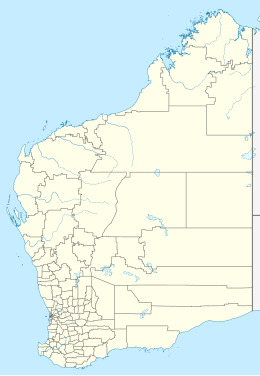
A wallaby is a small or middle-sized macropod native to Australia and New Guinea, with introduced populations in New Zealand, Hawaii, the United Kingdom and other countries. They belong to the same taxonomic family as kangaroos and sometimes the same genus, but kangaroos are specifically categorised into the four largest species of the family. The term "wallaby" is an informal designation generally used for any macropod that is smaller than a kangaroo or a wallaroo that has not been designated otherwise.
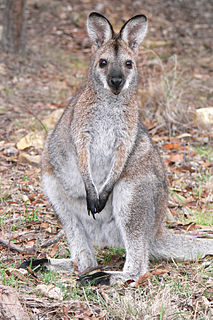
Macropodidae is a family of marsupials, commonly known as kangaroos, wallabies, tree-kangaroos, wallaroos, pademelons, quokkas, and several other terms. These genera are allied to the suborder Macropodiformes, containing other macropods, and are native to the Australian continent, New Guinea and nearby islands.

The brush-tailed rock-wallaby or small-eared rock-wallaby is a kind of wallaby, one of several rock-wallabies in the genus Petrogale. It inhabits rock piles and cliff lines along the Great Dividing Range from about 100 km north-west of Brisbane to northern Victoria, in vegetation ranging from rainforest to dry sclerophyl forests. Populations have declined seriously in the south and west of its range, but it remains locally common in northern New South Wales and southern Queensland. However, due to a large bushfire event in South-East Australia around 70% of all the wallaby's habitat has been lost as of January 2020.

Threatened fauna of Australia are those species and subspecies of birds, fish, frogs, insects, mammals, molluscs, crustaceans and reptiles to be found in Australia that are in danger of becoming extinct. This list is the list proclaimed under the Australian federal Environment Protection and Biodiversity Conservation Act 1999. The classifications are based on those used by the World Conservation Union (IUCN), however IUCN and Australian rankings do differ. Each state and territory has its own legislation relating to environmental protection.

The yellow-footed rock-wallaby, formerly known as the ring-tailed rock-wallaby, is a member of the macropod family.

The black-flanked rock-wallaby, also known as the black-footed rock-wallaby or warru, is a species of wallaby, one of several rock-wallabies in the genus Petrogale. A shy, nocturnal herbivore, its two main subspecies are found in mostly isolated populations across western and southern Western Australia (WA), the Northern Territory and parts of South Australia (SA). With some subspecies showing a decline in populations in recent years, the whole species is classed as an endangered species under the Commonwealth EPBC Act.
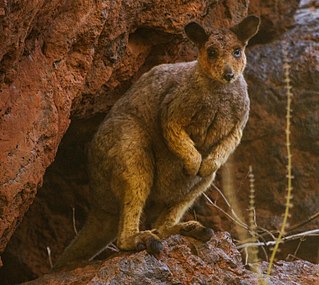
The rock-wallabies are the wallabies of the genus Petrogale.

The short-eared rock-wallaby is a species of rock-wallaby found in northern Australia, in the northernmost parts of the Northern Territory and Western Australia. It is much larger than its three closest relatives, the eastern short-eared rock-wallaby, the nabarlek and the monjon.

The monjon is a common name for the species Petrogale burbidgei, the smallest of the rock-wallabies (Petrogale), found in the north-west Australia. They are restricted to a small area of the Kimberley region and on nearby islands in the Bonaparte Archipelago.
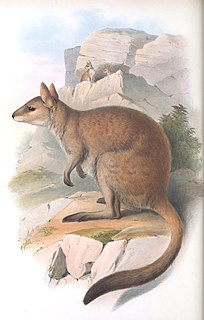
Nabarleks, are a tiny species of macropod found in northern Australia. They are a shy and nocturnal animal that resides in rocky hollows and forages in the surrounding area. Their diet is grasses, sedges, and ferns found in and around their scrub covered refuges. They are distinguished by a reddish tinge to the mostly grey fur and a distinct stripe at the cheek. They move with great speed and agility when observed, with a forward leaning posture and a bushy tail that arches over the back.

Rothschild's rock-wallaby – sometimes known as the Roebourne rock-wallaby, is a species of macropod found in Western Australia, in the Pilbara district and the Dampier Archipelago. It is not currently considered to be threatened, but is at risk from the red fox.

The allied rock-wallaby or Weasel rock-wallaby is a species of rock-wallaby found in northeastern Queensland, Australia. It forms part of the P. lateralis/penicillata species complex and is very similar to six other species of rock-wallaby found in this area; these include the Cape York rock-wallaby, the unadorned rock-wallaby, the Herbert's rock-wallaby, the Godman's rock-wallaby, the Mareeba rock-wallaby and the Mount Claro rock-wallaby.

The Mareeba rock-wallaby is a rare species of rock-wallaby found around Mareeba in northeastern Queensland, Australia.
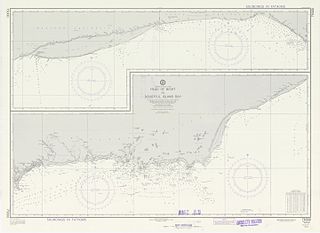
The Archipelago of the Recherche, known locally as the Bay of Isles, is a group of 105 islands, and over 1200 "obstacles to shipping", off the south coast of Western Australia. The islands stretch 230 km (140 mi) from east to west and to 50 km (31 mi) off-shore encompassing an area of approximately 4,000 square kilometres (1,544 sq mi). The western group is near Esperance and the eastern group at Israelite Bay. They are located in coastal waters, part of which is designated the Recherche Archipelago Nature Reserve.
Buckaringa Sanctuary is a 20 km2 nature reserve in the southern Flinders Ranges of South Australia. It is 30 km north of the town of Quorn. It is owned and managed by the Australian Wildlife Conservancy (AWC).
Middle Osborn Island is an island off the coast of the Kimberley region in Western Australia.
South West Osborn Island is an island off the coast of the Kimberley region in Western Australia.

The eastern short-eared rock-wallaby or Wilkins' rock-wallaby is a species of rock-wallaby found in the northernmost parts of the Northern Territory of Australia, and is common in the Kakadu and Litchfield National Parks. It was thought to be a subpopulation of the short-eared rock-wallaby Petrogale brachyotis found in the Kimberley, but recent genetic and morphological studies have shown it to be distinct. Wilkins' rock-wallaby is smaller, has more distinct grey/brown markings on its head and sides, and more colourful limbs than the western species.
